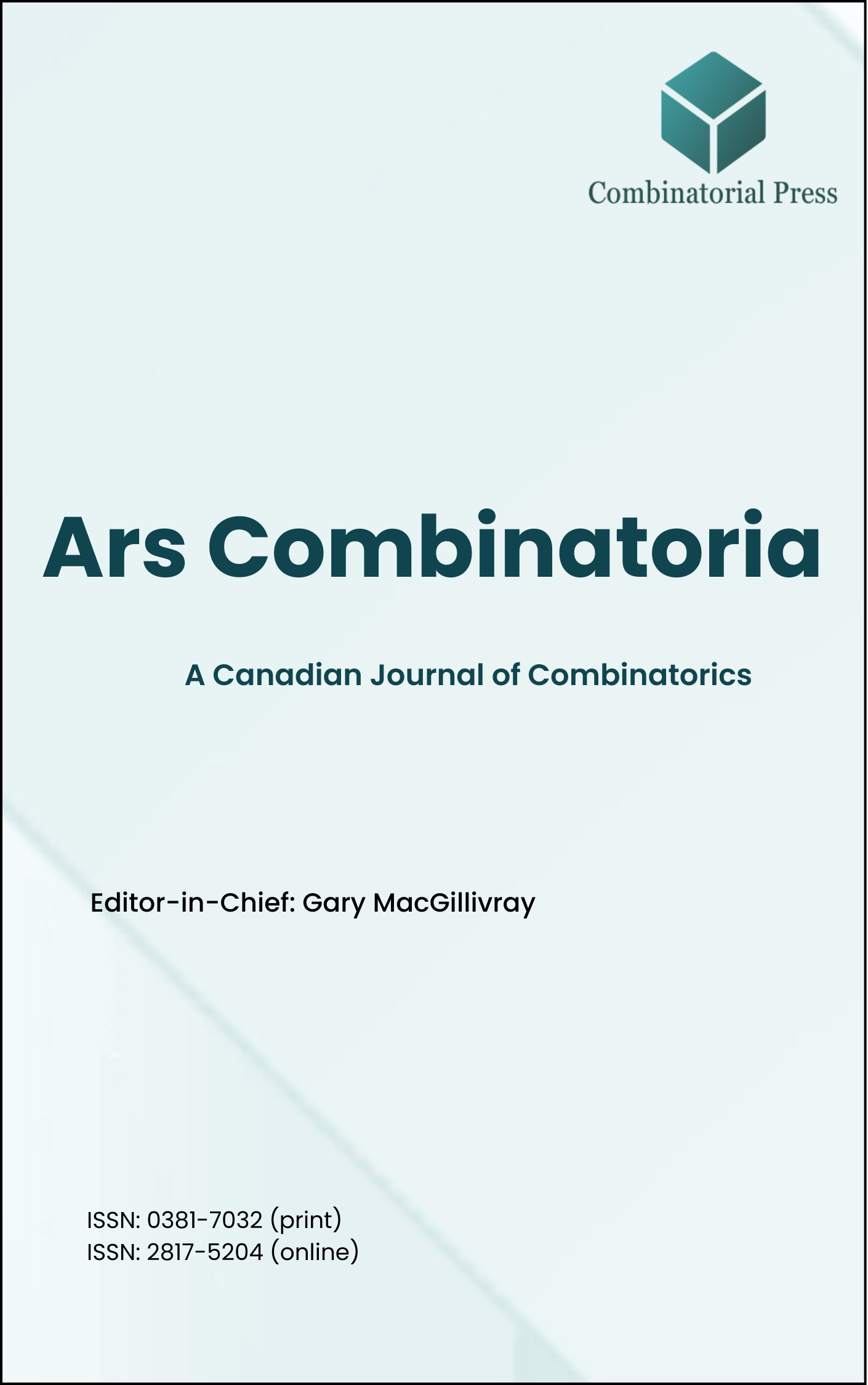
Ars Combinatoria
ISSN 0381-7032 (print), 2817-5204 (online)
Ars Combinatoria is the oldest Canadian Journal of Combinatorics, established in 1976. The journal is dedicated to advancing the field of combinatorial mathematics through the publication of high-quality research papers. From 2024 onward, it publishes four volumes per year in March, June, September and December. Ars Combinatoria has gained recognition and visibility in the academic community and is indexed in renowned databases such as MathSciNet, Zentralblatt, and Scopus. The Scope of the journal includes Graph theory, Design theory, Extremal combinatorics, Enumeration, Algebraic combinatorics, Combinatorial optimization, Ramsey theory, Automorphism groups, Coding theory, Finite geometries, Chemical graph theory but not limited.
Information Menu
- Research article
- Full Text
- Ars Combinatoria
- Volume 099
- Pages: 65-73
- Published: 30/04/2011
In this paper, we study the circular choosability recently introduced by Mohar \([5]\) and Zhu \([11]\). In this paper, we show that the circular choosability of planar graphs with girth at least \(\frac{10n+8}{3}\) is at most \(2 + \frac{2}{n}\), which improves the earlier results.
- Research article
- Full Text
- Ars Combinatoria
- Volume 099
- Pages: 55-64
- Published: 30/04/2011
An orientation of a simple graph \(G\) is called an oriented graph. If \(D\) is an oriented graph, \(\delta(D)\) its minimum degree and \(\lambda(D)\) its edge-connectivity, then \(\lambda(D) \leq \delta(D)\). The oriented graph is called maximally edge-connected if \(\lambda(D) = \delta(D)\) and super-edge-connected, if every minimum edge-cut is trivial. If \(D\) is an oriented graph with the property that the underlying graph \(G(D)\) contains no complete subgraph of order \(p+1\), then we say that the clique number \(\omega(D)\) of \(D\) is less or equal \(p\).
In this paper, we present degree sequence conditions for maximally edge-connected and super-edge-connected oriented graphs \(D\) with clique number \(\omega(D) \leq p\) for an integer \(p \geq 2\).
- Research article
- Full Text
- Ars Combinatoria
- Volume 099
- Pages: 45-53
- Published: 30/04/2011
A proper total coloring of a graph \(G\) is called Smarandachely adjacent vertex total coloring of graph if for any two adjacent and distinct vertices \(u\) and \(v\) in \(G\), the set of colors assigned to the vertices and the edges incident to \(u\) doesn’t contain the set of colors assigned to the vertices and the edges incident to \(v\), vice versa. The minimal number of colors required for a Smarandachely adjacent vertex total coloring of graph is called the Smarandachely adjacent vertex total chromatic number of graph. In this paper, we define a kind of \(3\)-regular Multilayer Cycle \(Re(n,m)\) and obtain the Smarandachely adjacent vertex total chromatic number of it.
- Research article
- Full Text
- Ars Combinatoria
- Volume 099
- Pages: 33-43
- Published: 30/04/2011
A perfectly one-factorable (PIF) regular graph \(G\) is a graph admitting a partition of the edge-set into one-factors such that the union of any two of them is a Hamiltonian cycle. We consider the case in which \(G\) is a cubic graph. The existence of a PIF cubic graph is guaranteed for each admissible value of the number of vertices. We give conditions for determining PIF graphs within a subfamily of generalized Petersen graphs.
- Research article
- Full Text
- Ars Combinatoria
- Volume 099
- Pages: 25-32
- Published: 30/04/2011
In this paper, we give the generalization \(\{G_{k,n}\}_{n\in N }\) of \(k\)-Fibonacci and \(k\)-Lucas numbers. After that, by using this generalization, some new algebraic properties on these numbers have been obtained.
- Research article
- Full Text
- Ars Combinatoria
- Volume 099
- Pages: 19-23
- Published: 30/04/2011
Let \(K_q(n, R)\) denote the least cardinality of a \(q\)-ary code of length \(n\), such that every \(q\)-ary word of length \(n\) differs from at least one word in the code in at most \(R\) places. We use a method of Blass and Litsyn to derive the bounds \(K_4(5,2) \geq 14\) and \(K_4(6,2) \geq 32\).
- Research article
- Full Text
- Ars Combinatoria
- Volume 099
- Pages: 3-17
- Published: 30/04/2011
Let \(d_{q}(n,k)\) be the maximum possible minimum Hamming distance of a linear \([n, k]\) code over \(\mathbb{F}_q\). Tables of best known linear codes exist for all fields up to \(q = 9\). In this paper, linear codes over \(\mathbb{F}_{11}\) are constructed for \(k\) up to \(7\). The codes constructed are from the class of quasi-twisted codes. These results show that there exists a \((78,8)\) arc in \(\text{PG}(2,11)\). In addition, the minimum distances of the extended quadratic residue codes of lengths \(76\), \(88\) and \(108\) are determined.
- Research article
- Full Text
- Ars Combinatoria
- Volume 098
- Pages: 521-527
- Published: 31/01/2011
A complete arc of size \(q^2 – 1\) is constructed in the Moulton plane of order \(q^2\) for \(q \geq 5\) odd.
- Research article
- Full Text
- Ars Combinatoria
- Volume 098
- Pages: 511-520
- Published: 31/01/2011
On the basis of the joint tree model initiated and comprehensively described by Liu, we obtain the genus distributions of double pear ladder graphs (a type of new \(3\)-regular graphs) in orientable surfaces.
- Research article
- Full Text
- Ars Combinatoria
- Volume 098
- Pages: 501-510
- Published: 31/01/2011
The silicates are the largest, the most interesting and the most complicated class of minerals by far. The basic chemical unit of silicates is the \((\text{SiO}_4)\) tetrahedron. A silicate sheet is a ring of tetrahedrons which are linked by shared oxygen nodes to other rings in a two-dimensional plane that produces a sheet-like structure. We consider the silicate sheet as a fixed interconnection parallel architecture and call it a silicate network. We solve the Minimum Metric Dimension problem, which is NP-complete for general graphs.





